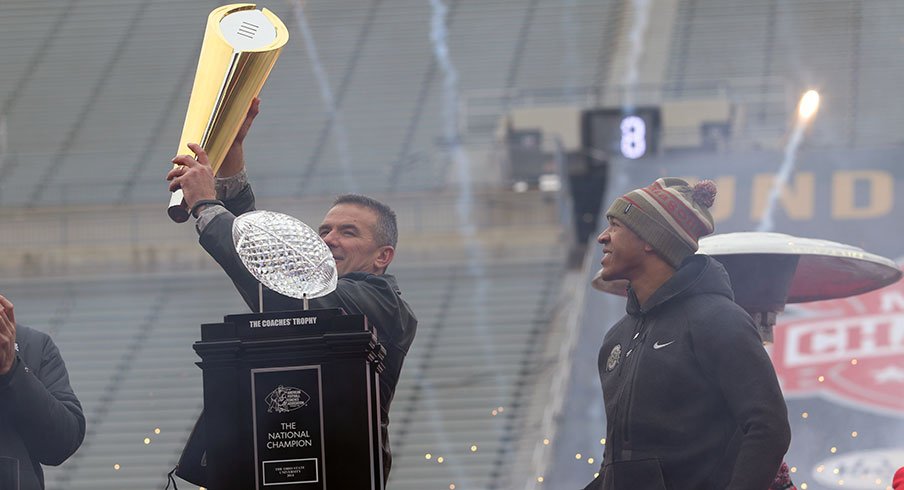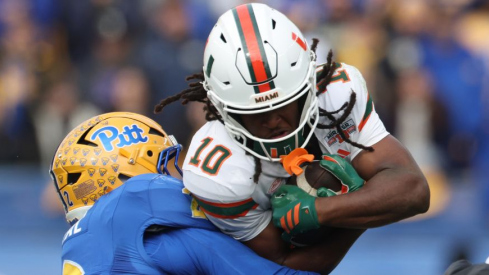In 1970, two years after his final national championship with the Buckeyes, Woody Hayes signed a recruiting class of 33 players. Ohio State's brand was strong, Hayes' place in Buckeyes' lore was firmly established and the NCAA's scholarship limitation didn't exist: it wasn't until the 1973 recruiting class that scholarship limitations were imposed, a move that took a bit of power away from the national powerhouses.
In February of 2017, two years after his most recent national championship with the Buckeyes, Urban Meyer is staring at–and trying to figure out how to manage–a roster with only six seniors. His 2017 recruiting class, the best in the country, already with twice as many (13) commitments as openings. Meyer isn't sure exactly how many Ohio State will sign in 2017, but it's a conversation he says needs to be had–and soon–because the power of the Scarlet and Gray brand right now is palpable.
"I think we should probably work on that," Meyer told the media when asked about numbers in 2017. "(We're) Kind of hot right now, guys want to come. So we just gotta be a little more diligent with how we're handling that. Nine guys leaving disrupted how many mid-year guys we got, everything. Those are all conversations we're having as we speak."
Want proof of Ohio State's national appeal?
Haskell Garrett, the country's fourth-ranked defensive tackle–who plays at national powerhouse Bishop Gorman in Las Vegas–committed to the Buckeyes literally one week after receiving a scholarship offer from Urban Meyer. One week, no visit ever to Ohio State –– committed. Why? Ohio State was the dream school for a kid with Hawai'ian roots who was born in Vermont and lives in Las Vegas. That kind of surprise commitment to a major program like Ohio State, without a visit, etc. may happen once every few years across the country, but when you're hot, you're hot. A month later JK Dobbins committed to the Buckeyes in a similarly out-of-the-blue manner: he's the 54th best player in America, he's from Texas, he's never visited Ohio State and committed to Tony Alford and Urban Meyer despite the fact that another running back, Ohio's Todd Sibley, was already verballed.
For Meyer, and for Ohio State, recruiting success isn't new; the Buckeyes have been a national name for decades. The newfound attention being paid to recruiting makes it seem like they're bigger than ever, but the fifth-year head coach says he doesn't think it's much different now than when he arrived on campus.
"I've always said many times...Ohio State's been a national name," Meyer said. "Players from all over the country come to Ohio State. you've gotta take care of your state first then go through it. That's kind of what we do."
That's what Ohio State has always done. Ohio first, then a push outward for the best players across the country who buy into the program and want to be a part of what you're building.
Woody Hayes' 1970 class had 21 Ohio preps and 12 guys from outside of the Buckeye State, but none from further away than New York (Ohio State actually signed two offensive lineman from Amityville, New York that year). Urban Meyer's 2016 recruiting class featured 25 players but only 10 from Ohio (40-percent, the smallest number of Ohioans in a class going back to at least that 1970 class). Ohio State reeled in players from New York to Florida, a testament to the growing brand but also a need to recruit nationally if you want to compete nationally, and the Buckeyes want to compete nationally.
Three hours north of Columbus, in Ann Arbor, Jim Harbaugh and Michigan are compiling a roster–built nationally–that they hope will allow the Maize and Blue to compete once again with Ohio State for Big Ten championships. Michigan's prep football scene is as good now as it has ever been but there are a number of folks in the state that feel some frustration with Harbaugh for not making in-state recruiting a bigger priority. When Urban Meyer arrived on the scene in 2011, his staff felt a similar pushback from fans and coaches alike, though the on-field results they've experienced have allowed them a touch of leeway since.
In most cases, to land a player from Ohio, Meyer and his staff need to utter three words to any prospect: "We want you." That kind of power in-state brings with it a unique problem, one that has grown in recent years as the business of recruiting. The intense pressure of "giving love" to an Ohio prospect while making sure they're being thoroughly evaluated while you simultaneously recruit nationally at the same position one of Ohio's best plays before extending isn't an easy balancing act. You're providing your opponents the most simple, yet most effective, form of negative recruiting available by simply doing your job.
"Hey, Player X, did you see that Ohio State is recruiting Player Y, too? Well, they've offered him already, so they want him and guess what, they don't want you. We want you, Player X, we don't care that you're ranked as the No. 15 wide receiver and he's ranked No. 1 because we see you, not a ranking. You're even from their home state. What a slap in the face."
Nevermind that Team B would certainly prefer Player Y but has no chance to land him, all but forcing them to go all-in on Player X. On top of that, if Ohio State offers Player X, they know he commits immediately, all but eliminating them from landing Player Y, unless they take him later in the process and take the unseemly approach of pushing Player X then out of the class.
See how this works? It's a daunting and delicate task. There's no easy answer.
Ohio's 2017 recruiting class may be the the best in recent history. Given 1970's scholarship freedom, Meyer and the Buckeyes could easily find 20 players from Ohio to take come next February, instead, with numbers limited and national appeal so broad, there are only five currently committed players from Ohio among the 13 early pledges. There are only three uncommitted in-state prospect that have a Buckeye offer right now, and Ohio State, which aims to land between 8-10, is leaning towards the smaller end of that target at the moment.
Recruiting isn't for the feint of heart, and in a world that is formed almost entirely on trust, comfort and relationships, the challenges for Meyer and his staff are growing more and more prominent.
Last Friday, as ESPN, the NFL Network, BTN and hundreds of media members descended on Ohio State, recruiting eyes all over the country opened. Talented players from coast-to-coast had an inside look at a program that players from inside Ohio have dreamt of being involved in their whole life. Successes on the field bring with it success in the living room and that means the best of the best are knocking down your door and hoping to become the next face of your program.
Ultimately, whether a signee is from Ohio or California, Florida or New York, the goal of winning championships with an honorable and integrity-filled program doesn't change. To strike the right balance, Meyer and Ohio State will have to continue to mix the old and the new, holding tight to tradition and expanding their recruiting presence in new and innovative ways that showcase the value of the Buckeye brand.


